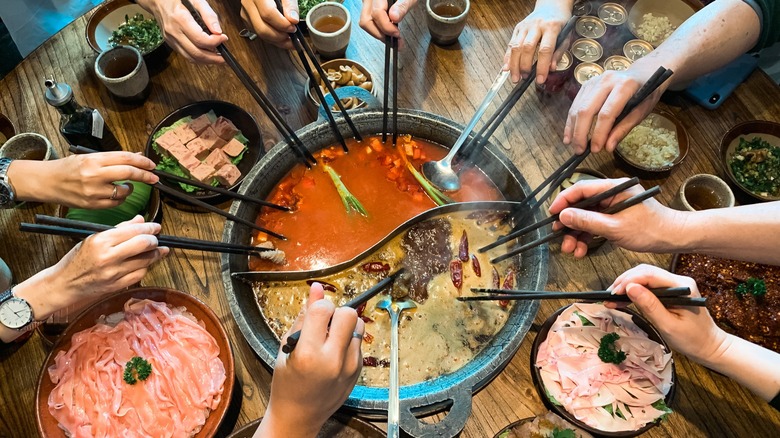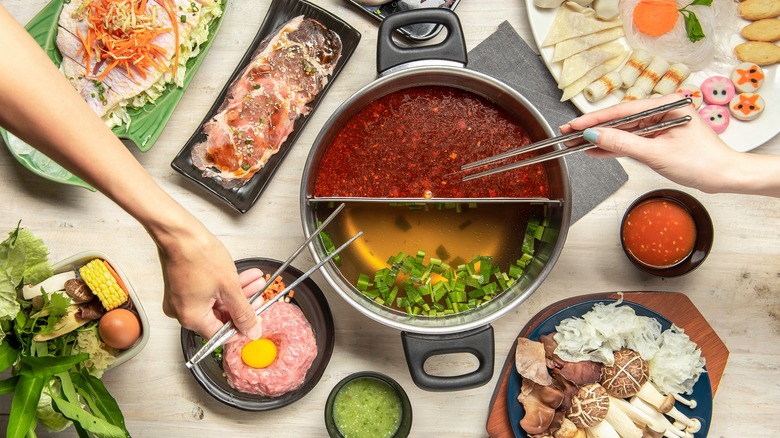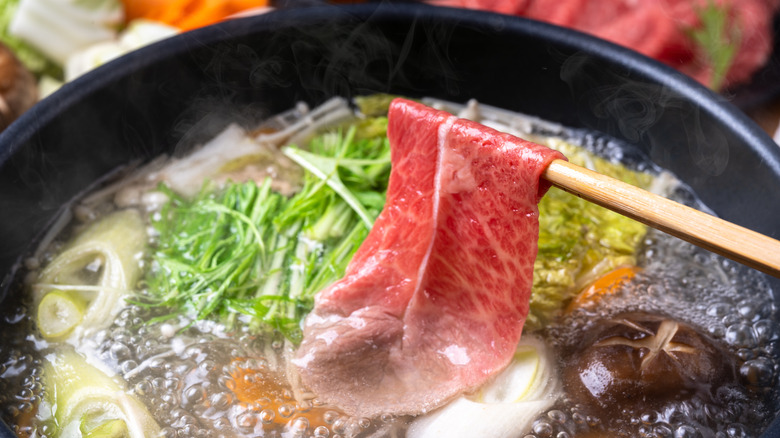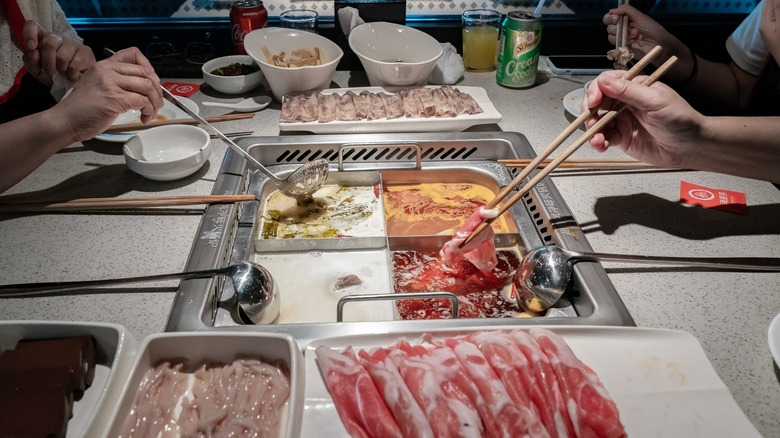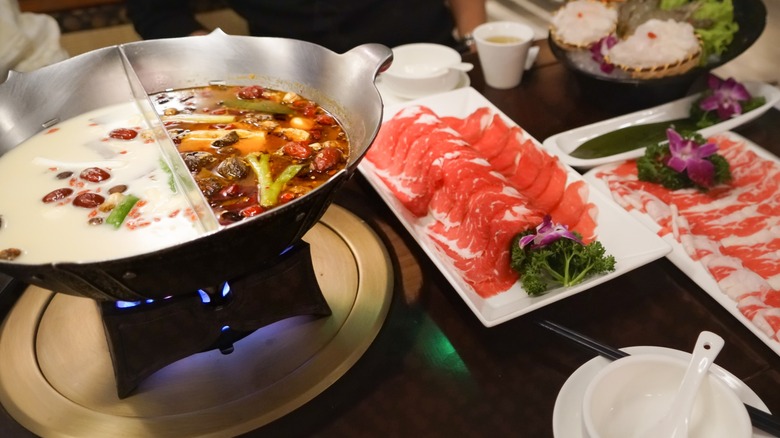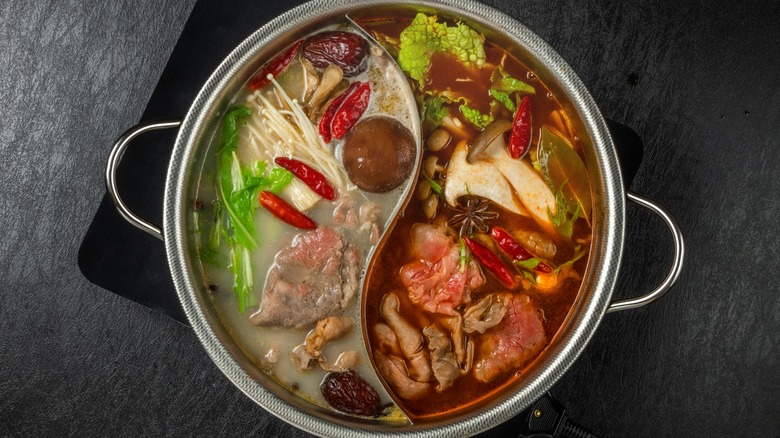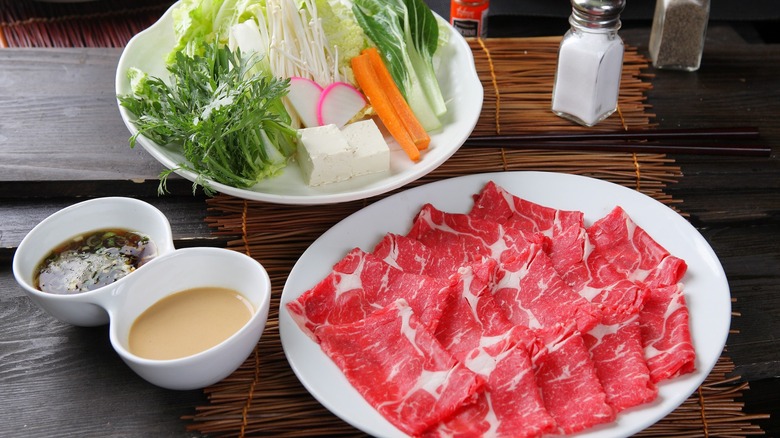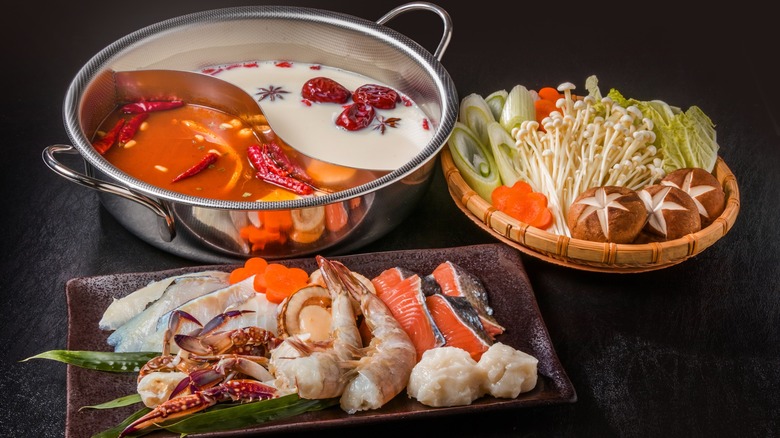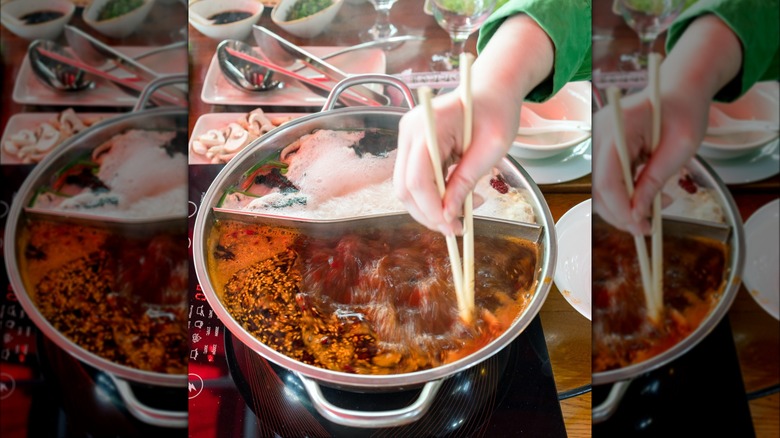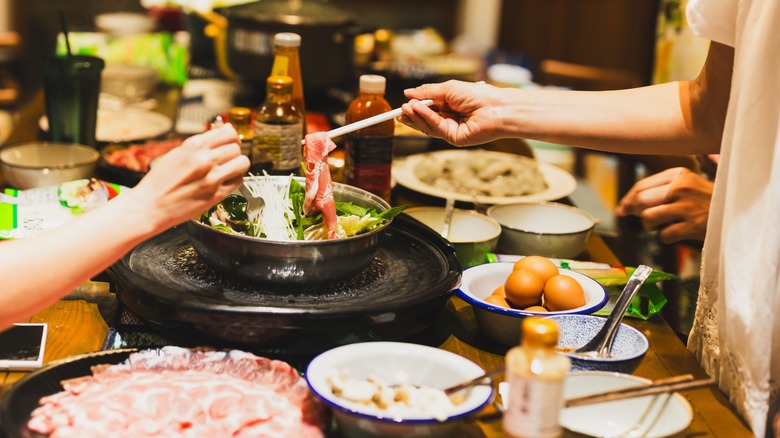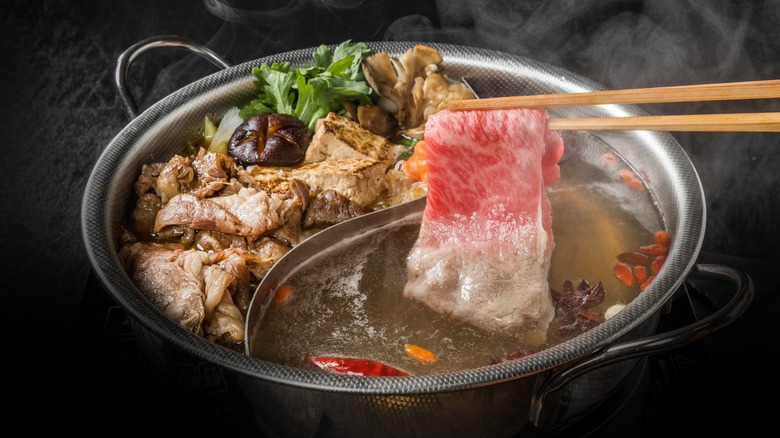The Ultimate Guide To Ordering Chinese Hotpot
Chinese hotpot is a delicious way to enjoy a communal meal with friends and family, cooking your own meat, vegetables, dumplings, and more at the table. But how much do you really know about Chinese hotpot? What exactly is it, what are its origins, and how do you participate?
As a self-confessed lover of Chinese hotpot, I've eaten at my fair share of hotpot restaurants around the world and know a thing or two about hotpot etiquette and customs. For this ultimate guide, I've also consulted other guides and sources on Chinese hotpot.
Are you unsure about how to order Chinese hotpot? Or perhaps you don't feel confident about how to eat hotpot when you're at a restaurant? Ensure you're in the know next time you visit your local Chinese hotpot restaurant — or enjoy hotpot on your trip to China — and pick up some handy tips along the way with this ultimate guide.
What is Chinese hotpot?
The easiest way to think of Chinese hotpot is like fondue. Hotpot is an experience designed to be shared with loved ones rather than a specific dish.
In China, the name "Huo Guo/火锅" literally means "fire pot." When you order hotpot, you'll get a steaming pot of broth set over a heat source on the table, with various platters of raw ingredients to cook in the pot. This varies, depending on what you order, but usually includes meat, fish, seafood, vegetables, and sometimes dumplings.
Some hotpot restaurants have a yin-yang option where the pot is divided into two halves so that you can cook your ingredients in two different broths. The idea behind hotpot is to cook each ingredient and eat it as you go along, making hotpot a great party meal or casual communal dining option to enjoy with friends or family, whether you're celebrating a special occasion or just getting together over a meal.
The origins of Chinese hotpot
Legend says that hotpot dates back at least 1,000 years and was the brainchild of the Mongols, who needed something hot and hearty to fuel them after spending long hours on horseback during their invasion of China. At the time, mutton and horse meat were used for hotpot.
Later, hotpot reached the Forbidden City (modern-day Beijing) and was a favorite of Emperor Qianlong. According to the imperial dining archives, Qianlong ate hotpot over 200 times in one year!
Other stories claim hotpot originated in Chongqing (known today as the hotpot capital) in southwest China and was the creation of sailors looking for a cheap meal. The meat used was generally internal organs and discarded animal parts from nearby markets.
Hotpot isn't unique to China, though. Other cultures have their own take on this delicious experience, too. Japanese hotpot is known as nabemono, with varieties known as shabu-shabu and sukiyaki, while in Cambodia, yao hon is a type of hotpot with broth made from fish sauce and soybean paste, sometimes with coconut soda.
Where to find the best Chinese hotpot
Most Chinese hotpot restaurants understand how to make this cuisine special, and it shouldn't be too hard to find a good hotpot eaterie if you live in a major city. Some smaller restaurants will have hotpot on the menu alongside other dishes, but for the ultimate experience, we'd recommend a dedicated hotpot restaurant.
If you're lucky enough to live in a city that has its own Chinatown, we would recommend heading there to hunt down an authentic hotpot experience. But even smaller, less authentic restaurants offer great hotpot, and there are hotpot chain restaurants, too. You can't really go wrong.
If you're on a trip to China, head for Chongqing, the reputed birthplace of the hotpot. This is where you'll find some of the most authentic and delicious hotpot around, and you'll be spoiled for choice when it comes to restaurants. Xiao Tian E (Little Swan Hot Pot) is a popular spot with locals and a great place for those new to hotpot.
What to expect when ordering Chinese hotpot
There are three key components to hotpot: The broth, dipping sauces, and ingredients to cook. Most hotpot restaurants will provide you with a paper menu with boxes you check to indicate what you'd like to order. At first glance, menus can seem overwhelming, but they're usually divided into clear categories such as meat, meatballs, seafood, veggies, and more.
The key to ordering hotpot is to start small. Order a few trays of meat for the table and perhaps one tray of vegetables, plus some meat or vegetable dumplings, if they're on offer. It's better to go back and order more rather than over-order and end up wasting food — you'll quickly get a feel for how much to order as you go along.
When the server arrives at your table with the broth, they'll likely set your burner to high. You can adjust this to suit once you start cooking your ingredients.
How to hotpot: It's all about the broth
The key to a delicious hotpot is the broth, so make sure you order plenty of ingredients that will give it bags of flavor. Beef and lamb are highly recommended for a deeply rich, savory broth. Ingredients such as shrimp, crab, and fish balls will also pack umami into your broth.
Broth styles will vary depending on the restaurant you're eating at or the region of China you're in. Sichuan hotpot (Ma la) and Chongqing are the most common types of broth. Both are packed with Sichuan pepper and peppercorns and are incredibly spicy.
Most hotpot restaurants will also offer milder options and mushroom or vegetable-based broth. Some might offer more eclectic choices, while others may have a simple chicken broth with ginger and spices on the menu. Some of the most popular hotpot restaurants provide a yin-yang hotpot with two sides, so you can order two different broths to suit all tastes. This is an excellent quirk if some diners are craving a more spicy broth.
Choose your dipping sauce
Once you've cooked your meat, seafood, fish, or vegetables in the hotpot, it's all about the dipping sauce. Typical Chinese hotpot sauce is a sesame paste with beancurd and a few other ingredients, but again, this may vary depending on the region of China you're in or the restaurant you're visiting, wherever in the world it is.
Some hotpot restaurants have a station dedicated to dipping sauce where you can make your own, either using the sesame sauce as a base or starting completely from scratch. Other restaurants will serve a variety of sauces and toppings in ramekins on the table.
Choosing the perfect dipping sauce comes down to personal taste and preference and should complement the broth, so if you're going with a super-spicy broth, choose a milder sauce with sesame oil to counteract the heat.
For seafood, a sacha sauce (made with fish and spices) is the perfect accompaniment. Peanut sauce is another popular choice. You can add whatever you want to your sauce, including soy sauce, hoisin, fermented bean curd, sriracha, minced garlic, cilantro, or scallions.
What other ingredients to order
The meat and seafood offered at Chinese hotpot restaurants will vary, but you can typically expect pork belly, beef tendon, tripe, squid, shrimp, and crab, alongside a colorful array of vegetables. Adding potatoes and tofu to your hotpot is a great idea, as these soak up all the delicious flavors of the broth.
It's easy to get carried away with the meat and seafood, but don't forget those tasty veggies, from beansprouts to daikon and Chinese cabbage. Noodles and dumplings are usually on offer, too, as well as eggs to add to the hot broth.
Many hotpot eateries offer refreshing salad and a variety of sauces, with the cool salad a refreshing break from the spicy hotpot. We highly recommend washing everything down with plenty of ice-cold beer, too.
As we mentioned earlier, don't be tempted to over-order, particularly if it's your first time at a hotpot restaurant. Yes, everything looks so tempting, but try a couple of trays of meat and one vegetable tray for a small group of diners. You can always order more as you work your way through the ingredients.
Slow-to-cook ingredients go in first
The most important thing to remember is that not everything you're adding to the broth cooks at the same rate. This means it's important to add those ingredients that take longer to cook to the pot first.
Slow-to-cook ingredients include potatoes, radish, pumpkin, and other veggies, which should be placed into the broth and retrieved with the provided slotted spoon once they're cooked. The same goes for dumplings, which can take a while to cook through.
Meatballs should be added to the broth using the provided spoon — they'll float to the top once they're ready. Most meat comes very thinly sliced, taking anywhere from ten seconds to a few minutes to cook — you can dip the raw meat in the broth using the provided chopsticks, then transfer it to your plate (but use a separate set of chopsticks for eating the cooked meat!)
Spinach, cabbage, lettuce, and other leafy vegetables should be added to the pot last. These only take a couple of seconds to cook through, so they retain their vibrant color and crunchy texture.
How to eat Chinese hotpot
Your server will normally set your burner to high, so the broth should be simmering before you add ingredients. You can adjust the heat as necessary to prevent the hotpot from splashing other diners.
Everyone gets chopsticks and a small bowl or plate. There will also be mesh or metal slotted spoons on the table to stir the broth and fish out ingredients such as dumplings and potatoes. You'll find a few extra chopsticks designed to add raw ingredients, such as meat or seafood, to the pot.
Meats arrive thinly sliced on a platter with tongs. Fish and other ingredients are similarly served at the table. The best part of Chinese hotpot is that it's a casual, fun experience, and there are no rules. Add whatever you feel like eating to the pot and serve it on your plate once it's cooked. Just remember to add ingredients carefully and slowly so you don't splash other diners with hot broth.
Don't mix your utensils
This next point is an important one. When at a hotpot restaurant, you'll usually be given a variety of utensils, including tongs, chopsticks, slotted spoons, and mesh spoons. Be careful not to mix these up.
Don't ever use the same chopsticks for cooking raw meat as you do for eating the cooked meat. Keep each utensil next to the food item or group it's intended for to avoid the risk of cross-contamination and possible food poisoning.
On that same note, don't be the person at the table who double-dips. Dunking your meat in the shared sauce, taking a bite, and then dunking it again is rude and unhygienic. The communal nature of hotpot means there's no double dipping allowed. The exception to this is, of course, if you have your own pot of sauce that you're not sharing with others — then you can dip to your heart's content.
Five tips for happy hotpot-ing
Now you know the basics of what to expect from Chinese hotpot and how to order, it's time to share some handy tips so you can hotpot like a pro! Whether at a local hotpot restaurant or traveling through China, these tips will ensure you're a hotpot expert.
The first tip is to bring tissues. Things can get spicy and messy, and though there will already be napkins on the table, tissues (or even wipes) are a welcome addition for messy faces and hands, particularly if you're dining with kids. Next, you should try to avoid over-ordering. This is surprisingly easy to do, so start out with a few platters and go from there.
Another tip is to cook as you go. Don't add everything you want to eat throughout the meal to the pot in one go. Ingredients will become mushy and break down in the broth, so add things as you plan to eat them, and don't forget about them!
You should also remain open to trying something new. Hotpot is all about experimenting, so it's a great time to try some new meat, fish, or seafood. You might also want to consider sampling different sauces to see which flavors complement each other.
And finally, add flavorful food to your hotpot first. Ingredients such as beef, lamb, mushrooms, or seafood will give the broth tons of rich flavor, which will, in turn, ensure everything you cook tastes mouth-wateringly delicious.
